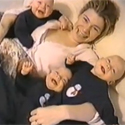The majority of plastic baby bottles marketed to parents of young children has known carcinogens and can leak these toxins over time when washed with harsh dishwashing soap. Recent tests have also shown that BPA can and do migrate from polycarbonate when used in a microwave oven. Besides baby bottles, a common source of plastic used in food storage can be found in the plastic polycarbonate lining of cans used to store and sell baby food. Another known plastic that can leach unfriendly toxins are based on Polyvinyl chloride or PVC.
Pregnant women should avoid BPA derived polycarbonate bottles and refrain from eating canned foods. The plastic lining in food cans contain polycarbonate. BPA is known to mimic the behavior of DES, an artificial estrogen banned for use by pregnant and nursing mothers. Since most plastic is made using BPA and the labels do not normally indicate the use of this toxin, it is important look at the bottom of the plastic container or baby bottle and check the SPI code in or around the recycling triangle. It is also important to note that SPI labeling requirements vary between states in the USA.
The first of the SPI codes represents the plastic resin PET or PETA and is represented by the number 1 inside the recycle triangle on the label or bottom of the container. These have no known hazards and are supposedly BPA free. The second SPI code represents the plastic resin HDPE and is represented by the number 2 inside the recycling triangle. HDPE has no known hazards and is used heavily in plastic toys.
The third plastic is called PVC and we know this to be commonly used in PVC pipes, but it can also be found in plastic food wraps, so look for the number three in the recycling triangle. Low Density Polyethylene is commonly known as LDPE and is plastic number 4, there are no known hazards as in BPA derived plastics, one reason why it is used in plastic food packages and soft sport bottles. Polypropylene is a BPA free plastic and is plastic number 5 or PP in the SPI code. You can find this plastic used in food containers for storing butter and yogurt. Following PP is the plastic used commonly in egg cartons, known as PS, using the SPI code number 6.
With the advent of new resin combinations, the SPI code included the number 7 designated as OTHER to differentiate these plastics from SPI codes 1 - 6. Many plastics were clumped under SPI code 7 including BPA derived polycarbonates and natural non-hazardous plastics.


0 comments:
Post a Comment